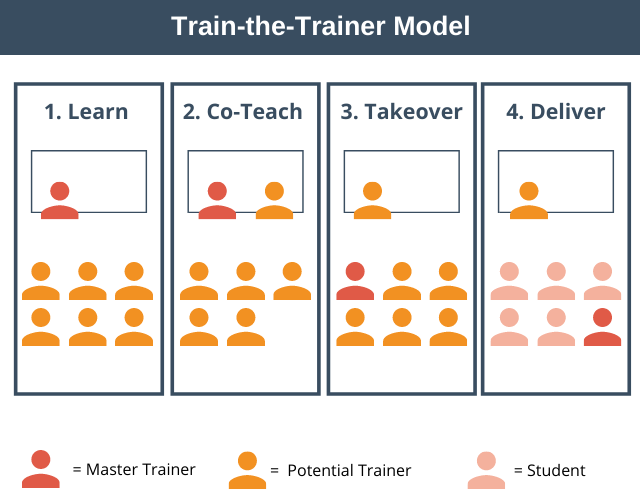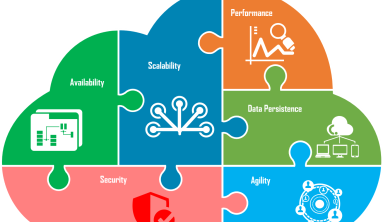Train the trainer is a concept that can be applied to almost any field. However, it’s not easy to understand what train the trainer really means or how it works.
You know you need training for your team but you don’t know where to start or how much time and money will be needed. It feels like there are too many options!
We’ve created this guide so that anyone can learn about train the trainer in just 10 minutes. This guide covers everything from what is the train the trainer concept? why companies use it? who benefits from training their trainers and more!
What is the Train the Trainer concept?
The Train the Trainer concept is a training strategy in which experienced trainers train other people, who will then use the concepts to facilitate further training.
Trainers are required for development of any organization or company because they act as an interface for transferring knowledge and skills to the employees. They play an important role in developing employees, enabling them to share their knowledge and skills with other employees and transferring what they have learned to the new employees.
Trainers face difficulty in conducting sessions because of lack of skilled people to train, which leads them to search for individuals who can be trained to become instructors. When you train someone as a trainer it is called as “Train The Trainer Approach” or “Train the Trainer Concept”.
Train the Trainer is a method of using experienced trainers to train current trainers how to facilitate specific training programs with their employees. The idea behind this concept is that these new trainers can then pass on their knowledge and skills to other members of the organization/company through facilitated learning sessions, virtual classrooms or face-to-face training.
The concept in itself is very broad and can be used to train trainers in a variety of different topics. Some examples would be: the creation of an online course, facilitating training sessions or even how to use a specific software application within the organization/company.
Trainers who will be trained as instructors will get knowledge about what should they be discussing, how it should be presented. What examples can be used to explain a given topic etc.
Trainers who have been trained as instructors will now know what they are supposed to do and they can pass on knowledge and skills to other employees or lower level trainers in the organization/company. In many cases, they will become part of a company’s coaching team.
Trainers who have been trained will have more confidence when training other employees because they know what needs to be done. They will also feel confident enough to help other trainees or trainers when needed because they can do both, facilitate a training session or coach someone else through the program.
Although this model may sound good in theory, it doesn’t always work out in practice. Some companies or organizations use the train-the-trainer approach at the beginning of a program, but after some time they realize that the person is not performing well enough and has to search for other trainers anyway.
How does it work?
Trainers are first selected to undergo training. The trainers are then trained on how the online courses should be designed, what activities can be used to make it more interactive, how effective use of voice and video recordings can engage the trainees etc.
After the completion of this course, they are now ready to provide training sessions. They will know what topics should be covered in a specific training session, which activities can be used to teach skills effectively and how online courseware tools should best be implemented within their organization/company.
Benefits of using this model in training

1. You decrease your time spent developing learning material by 50% or more while also increasing the quality of information presented during sessions because employees are actively engaged with other participants within these contexts.
2. Employees feel more confident about leading training sessions because it gives them a chance to improve their knowledge and skills prior to actually doing so while also allowing them to have more opportunities to practice what they know for future sessions.
3. Employees feel more comfortable discussing questions about anything that happens within training sessions because they now realize that their opinions and ideas are valuable as well as appreciated by everyone else who is taking part in these activities, including the clients/customers who will be receiving learning material from trainees following future sessions within a similar context.
4. The company/organization saves money on developing learning materials/presentation styles for employees because this task has been shifted to a wider group of people who may also develop creative presentations/learning methods which can help make training sessions even better than before.
5. By shifting the responsibility of creating learning material from one person or small group of people to a larger group, this encourages a feeling of community among employees and allows the company/organization to become more invested in future training sessions.
Limitations of the Model
1. If the trainer fails, then all trainees fail at learning that specific segment of information within a program. This can be made up for in future training sessions but it slows down the process by which other employees can become better trained.
2. Trainers might not have any control over their own budget/resources used to create these training materials leading to less creativity and innovation among other trainers or trainees following these sessions because they often feel as though they are facing limitations due to external factors outside of their control.
3. Employees who are participating in this type of training session might not feel comfortable sharing ideas or asking questions during periods where other participants are actively engaged with the trainer themselves or working through materials provided on their own time after work.
4. Trainers might not know how to teach a specific concept to employees who have varying levels of experience/understanding about the topic being discussed if they themselves do not have any experience managing or teaching others within a similar context. In this way, it is possible for the trainer to even make mistakes during these sessions because they are not sure what other workers can understand due to their own understanding of said program.
5. Employees might feel as though their questions and ideas are ignored by other participants or trainers because everyone else involved in training sessions follow different methods, etc. This could discourage employees from providing feedback/ideas after future sessions just as much as before the session itself which could lead to a lack of innovation among employees following these activities.
Train the trainer development can be a difficult and time consuming process. But there are some great techniques to help shorten your journey:
1. Give employees an opportunity to participate in training sessions, even if it’s only for one session. The more experience trainees get within this context, the better they will become at facilitating sessions on their own.
2. Be sure not to overload employees who have been designated as internal trainers with questions because this could frustrate these employees and impact the quality of their responses. They need to focus on other participant’s questions so that participants can feel confident that they fully understand what is going on during training sessions, but also feel free to ask other questions while engaging in selfstudy material before or after sessions.
3. Encourage employees who have been designated as internal trainers to create their own learning material and encourage them to share this information with other participants within future training sessions. This will give them a chance to practice these skills and it will also allow them the opportunity to help others learn something that they themselves may not be fully comfortable with yet.
4. Allow trainees to ask questions about anything that happens during training sessions, both before and after sessions, even if this means having multiple conversations with the same employee/trainee on different occasions. It’s important for trainees to feel free to discuss any concerns or comments they might have because this could lead to valuable dialogue between the organization/company and its employees/trainees.
5. Give employees who have been designated as internal trainers an opportunity to participate in any future training sessions. If they only get the chance to lead one session, this could be enough for them to feel confident about their ability to facilitate sessions on their own, which means they will hopefully want to continue participating in these types of activities within your organization/company.
How to Choose the Right Participants?
When a company needs to find people who can be trained as instructors, there are certain qualities that they should look for.
The first thing organizations/companies look for is self-awareness – the ability of an individual to recognize his or her own strengths and weaknesses and to understand where areas of improvement can be made. People with this level of awareness will know what topics they need to focus on during training sessions and how they should teach others new skills.
People who lack self-awareness would benefit from participating in instructor led courses because once they have participated, they will understand how their peers think and learn (and what kind of activities engage them), which will then enable them to conduct training sessions more effectively.
Another important quality that companies/organizations look for in people who will be trained as instructors is the need to constantly learn and grow.
The reason for this is because trainers who have a passion to improve themselves and their own skills, will ensure that they are always learning new things from others – either by reading articles online or taking courses from other academics/trainers. This mindset also enables them to keep looking for better ways of teaching ideas and skills within training sessions that can engage others.
People who enjoy learning new things will be eager experiment with different activities during training sessions – not only because they want to make sure each session includes a variety of activities, but also because through trial and error, they will ultimately discover what works best when communicating certain ideas or communicating specific topics within training sessions.
Each organization/company that wants to implement the “train the trainer” approach should put together a list of participants who meet all of these requirements. The goal is for them to feel comfortable facilitating training sessions with other employees, because if trainers are not confident enough in their knowledge or skills, they will end up taking longer to complete the sessions and employees will get frustrated.
Trainers need to know how long each session takes to complete and trainees need to be aware of what’s going on behind the scenes because it impacts their participation within training sessions. Trainers cannot expect group members to engage fully in a session if they are uncertain about what they are supposed to do or when things will begin or end.
By having internal trainers participate in training sessions, companies can ensure that employees are getting the most out of their time by engaging fully in these learning opportunities.
Examples of how to use Train the Trainer in your organization:
Train the trainer examples:
1. A newly hired manager trains other new managers to lead trainings for their peers in a format that addresses common questions and concerns from employees, while also teaching them how to answer certain challenges when conducting training sessions themselves. This program not only enables new managers to learn best practices from more experienced teammates, but it also gives them the confidence they need in order to effectively communicate ideas and concepts with large groups of people.
2. An organization uses a one-on-one approach when training employees who need additional guidance in terms of communication skills or public speaking abilities. These types of programs can be formal or informal – each one depends on what the company/organization decides is needed based on things such as HR budgets and time limitations.
3. Employees at a multinational company/organization have been struggling with certain aspects of their jobs because they do not understand how to use a certain software program. The organization decides that it needs to offer training sessions for employees in order for them to get the most out of the software, so an internal trainer conducts these workshops.
4. A well-known fast food restaurant chain has decided it wants to implement a “train the trainer” approach when it comes to its marketing strategy by having other employees conduct sales pitches during work hours in various locations throughout the city where this business is located. This allows employees from different areas within the company’s structure (i.e., upper management, middle management, front line staff) to work together on a new initiative that affects the entire organization.
5. An organization is looking to implement an online training program for employees because it wants them to receive information in a format that works best with their busy schedules. People are allowed to sign up for training modules based on what they need help with at any given time, which gives them the ability to learn important skills when it’s convenient for them rather than having trainers attempt to fit everything into each session.
6. A large corporation takes advantage of webinars as a way to train remote employees about upcoming changes within the company structure, company updates and feedback from senior management, among other topics. Employees who are unable to attend certain sessions can view recordings of these webinars so they can get all of the information they need in order to perform their jobs successfully.
7. A high school uses a “train the trainer” approach by having teachers and librarians work together so that students learn how to find reliable information online. Instead of relying on websites such as YouTube and Wikipedia, students are taught how to evaluate the credibility of certain sources so they can get more out of their research assignments.
8. Businesses use social media campaigns as a way to train employees about these new developments so they can carry out promotional activities or be able to answer customer questions if necessary, which ensures brand consistency throughout all levels within an organization. Employees need to understand potential risks involved with using this form of communication, but it is also important to know how to make social media work for your organization.
The train the trainer concept is used in many fields, but it’s especially important for trainers to be able to provide their own training. Trainers need to know how information will be processed by learners and what activities are best suited for them. This knowledge can help you create an effective learning experience that meets your learner’s needs. If you’re interested in becoming a better trainer or just want more information about this topic, check out our blog article on “Train the Trainer.”





